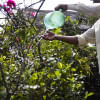A beginner’s guide to vegetable gardening

Many of us are just farmers at heart, but rarely get to explore that side due to urban living. The fulfilment of consuming the produce you grow with your own labour and effort can be irreplaceable. Final harvest aside, the smaller experiences along the way, be it the feeling of dirt on your finger tips or the sight of a new bloom are joyful on their own.
You do not necessarily need to live in the countryside to take up vegetable gardening as long as you can provide your plants with ample sunlight. Additionally, if you have ever had an urge to grow your own produce, winter is the perfect time to get started. Colder temperatures make vegetable gardening more beginner friendly as plants are usually less thirsty during winter months. Pests are less of an issue too when the temperature drops by a few degrees.
Check harvest windows
While there are various cold hardy leafy greens and vegetables to choose from for your garden, it is important that you check the time windows for harvest to ensure that the ones which only thrive in winter have enough time to grow before the heat returns. While some vegetables such as broccoli, cucumber, okra, and tomatoes can grow all year-round in warmer regions, others are more specifically suited for winter such as bitter gourd, cabbage, lettuce, and radish.
Even if the plants of your choosing are cold hardy, it is still crucial to plant them in an area of your balcony or garden which receives a few hours of direct sunlight.
Consider growing herbs
For many, growing herbs is the gateway to growing fruits and vegetables of all sorts. Freshly cut herbs tend to taste better than both dried herbs and ones found at grocery stores. Coriander, mint and holy basil are good options even during winter for tropical and subtropical climates.
One of the quickest ways to grow herbs is to propagate stem cuttings. All you need to do is cut four to five inches of a healthy stem, take the bottom leaves off and pop it in a glass jar filled with water. If your cuttings get enough light, a healthy root system should emerge around two weeks. After a stable root system is established, you can re-pot the plantling in an area which receives a few hours of direct sunlight every day.
Gathering all necessities
Before you get farming, you should try to get all the necessities which may come handy during the growing season. This may include a few tools such as shears, a spade, and a shovel. For vegetables and herbs, organic pesticide is the best way to go. Neem oil and neem oil sprays are some of the best organic pesticides which can be found locally. Try to get your hands on some organic fertiliser as well since fertilisers are extremely helpful during the time of planting, blooming and fruition.
Perfect the soil mix
If you plan to use containers or seed trays for your vegetable garden, ground soil will usually not do. Ground soil tends to be too heavy to offer adequate drainage. It also lacks the necessary nutrients. Many online nurseries provide customers with soil mixes specific to vegetables, and seedlings if needed. If you prefer to make your own soil mix, prepare a blend of 55-60 percent top soil, 30 percent organic matter and 10 percent of coco peat.
Adjustment requirements for balconies
If you plan to turn your balcony into a vegetable garden for winter, cherry tomatoes, chilli, peas, beet, and smaller varieties of carrots are your go to vegetables. These vegetables usually adjust to smaller spaces without compromising its root system. Most herbs thrive in balconies as well given that they receive enough hours of direct sunlight.
Although these vegetables do adapt to balconies, try to make sure the pot you choose is as big as possible so that the containers do not hinder growth. Some vegetables may even need pots deeper than twelve inches. Make sure that the pot has good drainage as well. This requires the pot to have a handful of drainage holes and a good potting mix.
It is best to place the pot in areas of your balcony which receives a few hours of direct sunlight, especially during the morning.
Lastly, try to be as patient as possible. The long wait for seedlings to turn into mature bearers of produce is what makes the process of eating what you sow extremely gratifying.

 For all latest news, follow The Daily Star's Google News channel.
For all latest news, follow The Daily Star's Google News channel. 








Comments